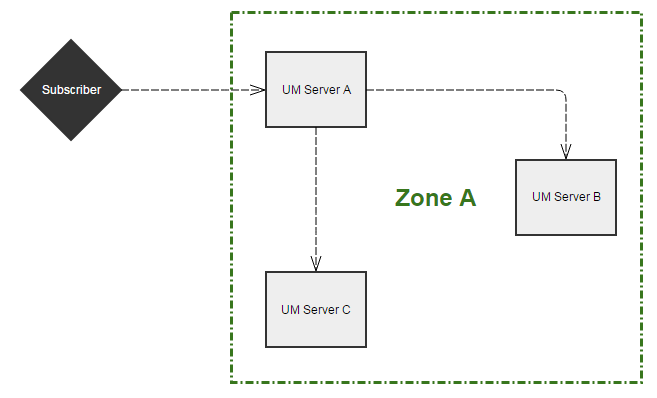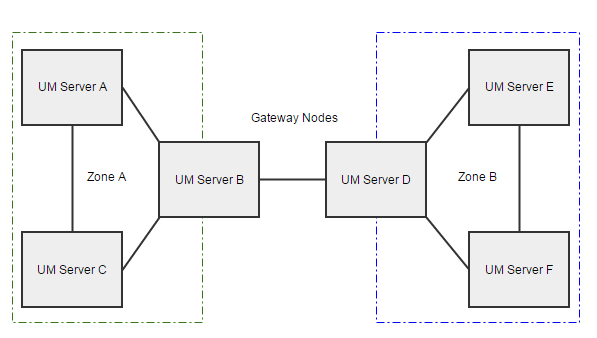Overview of Zones
Zones provide a logical grouping of one or more Realms which maintain active connections to each other. Realms can be a member of zero or one zone, but a realm cannot be a member of more than one zone . Realms within the same zone will forward published channel messages to other members of the same zone, if there is necessary interest on corresponding nodes.
Note:
The forwarding of messages between realms in a zone applies only to messages on channels, not to messages on queues. Messages on queues are not forwarded between realms in a zone.
Clusters can also be members of zones. In this case, the cluster as a whole is treated as a single member of a zone. Members of a zone should be well-connected, i.e., always connected to all other zone members, however this is not enforced.
Zones are uniquely identifiable, and two disparate zones with the same name can co-exist.
Interest Propagation
Using zones, Universal Messaging can deliver channel messages between realms and clusters when interest from one realm or cluster has been registered on another realm or cluster in the same zone. Here the term "interest" means that the realm wishes to receive a copy of messages that are sent originally to a channel of the same name on another realm within the same zone. This "interest" only arises on a realm when a client subscribes to a channel on the realm; if there is no such client on the realm, there is no "interested" client, so no interest propagation occurs.
A realm will forward its own interest in a particular channel to all realms directly connected to it within the same zone. When a realm receives a notification of interest from another realm within the same zone it will add an entry within its interest manager and begin to directly forward messages to this realm.
The mechanism within any given zone is as follows. The description assumes that there are several realms in the zone; we'll refer to the realm you are working on as the source realm and all the other realms as remote realms:

When a client subscribes to a channel on the source realm, the source realm indicates to the remote realms that it wishes to receive any messages sent to the channel on the remote realms. In other words, the source realm propagates interest for this channel to the remote realms.

Once interest from the source is registered on the remote realms, messages published to the channel on any of the remote realms in the zone will be propagated to the source realm.
Example: Propagating Interest within a Zone
In the example above we see that a client has subscribed to a channel on realm A. The Interest Manager for realm A forwards a notification to all other realms within the same zone (realm B and realm C). Realm B and realm C now know that they should begin to forward messages they receive for this channel to realm A.
As both realm B and realm C are members of the same zone they do not propagate this interest any further. Therefore realm B knows that realm C has no local subscriber and will not forward messages to realm C. Similarly, realm C will not forward messages to realm B.
Propagating Interest between Zones
You can propagate interest between zones using by manually creating static joins, for example:
Note:
Currently, a realm cannot be a member of more than one zone, so you cannot define a realm that is common to two zones. Therefore interest propagation between two zones using a common realm is not supported.

